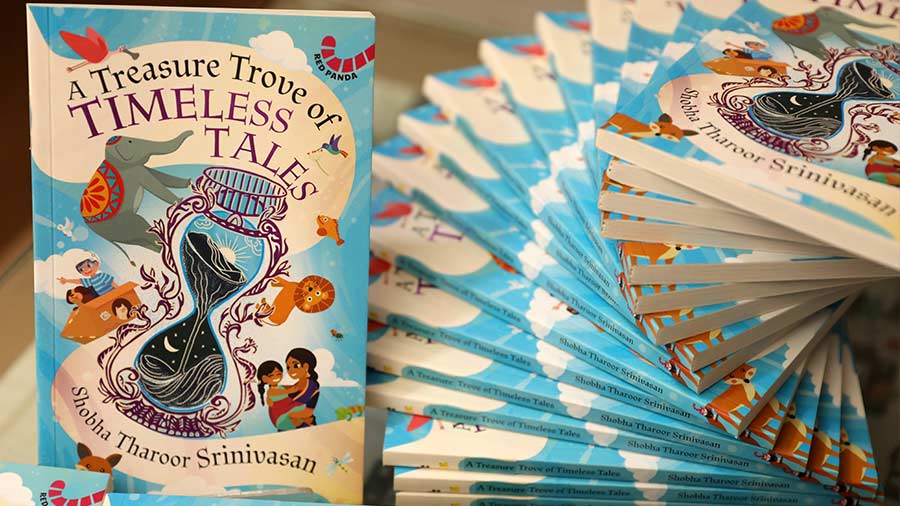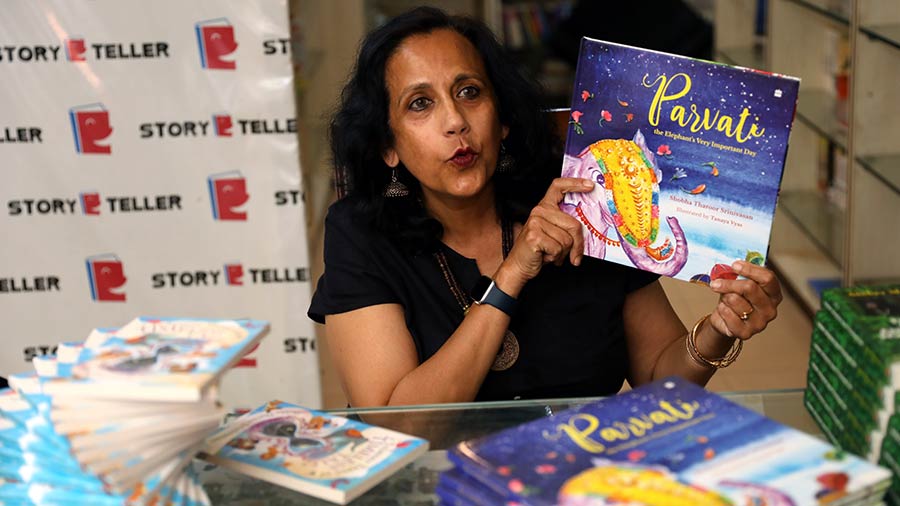Kayamkulam Kochunni, the 19th-century Robin Hood from Kerala; Kammapa, a fabled monster from Africa; and the tiny Issun Boshi from Japan come together in A Treasure Trove of Timeless Tales, published by Red Panda (October, 2022), Shobha Tharoor Srinivasan’s latest book. My Kolkata caught up with the author while she was in Kolkata for a book-signing session at the Storyteller Bookstore and discussed her book, style of writing, love for Kolkata and more. Edited excerpts from the conversation...
My Kolkata: How did you go about curating the diverse stories in the book — from folk tales to Aesop’s Fables and even lockdown stories?
Shobha Tharoor Srinivasan: The book is far more than a curation of tales. There are a number of original creations as well. There’s a glut of short stories for children in the market. I wanted to do something a little different. This collection of stories has both thematic as well as stylistic variety. I have a first person narrative as well as a memoir-style reflection. I have familiar beloved stories from the Panchatantra and Aesop, but I also include less familiar folktales from Kerala. When the publishers (Red Panda, 2022) asked for a retelling from the classics, I thought the stories could reflect not only the classical past, but also stories from your past and my past. This book brings in all kinds of stories including ones that come out of being stuck indoors which I have titled as Lockdown stories. These are all 100-word stories and I ask the reader to start their own writing with this short format. I wanted the book to have a takeaway so that children return to the stories from time to time. So, essentially it [A Treasure Trove of Timeless Tales] is a trove/collection of many varieties of stories that talk about different pasts.

‘‘A Treasure Trove of Timeless Tales’ is a trove/collection of many varieties of stories that talk about different pasts,’ says Tharoor Srinivasan
How important, according to you, is the format of storytelling in instilling values in children at a young age?
That’s an interesting question. This is not a collection of stories written in one particular style. There are 100-word stories, there are stories in first person, stories that are reflective, stories that are in the traditional fairy tale format that begins with ‘Once upon a time…’ and ends with ‘Happily ever after’. I want to show children that there are different ways of writing stories. I have even told a story in rhyming verse in Parvati the Elephant (Harper Collins, 2022). Today, we writers are aware that children have many distracting visual forms of entertainment including from television and video games, as well as from phones and other devices. So, a writer has to be very conscious about the ways in which they tell stories so that they can continue to keep the interest of readers. If you can have a really good adventure, a page-turning story, a long book is okay. But since I have been working with a shorter medium, I try to make each story, depending on how I’m framing the story, a little unusual to hold the reader’s interest. So even for an illustrated biography like the Ravi Varma story, Prince with a Paintbrush: The story of Raja Ravi Varma (Red Panda, 2021), instead of making it a linear narrative where I say Ravi Varma was born on this day and take it all the way to the end, which is what you sometimes do with a biography, I wanted to frame it in a different way so that today’s readers enjoy it. We have a double narrative in which an eight-year-old child discovers who Ravi Varma is and her own musings and comments inform the narrative. More than the writing I think about methods I should use to tell the story and frame the narratives.

Tharoor Srinivasan talks about her book ‘Parvati the Elephant’
How have your travels around the world inspired your writing?
More than my travels around the world, it is the fact that I went away as a young teenager to the Western world that has informed my thinking. I discovered early on how people are the same wherever they may be. They have similar thinking and impulses and are strengthened by family ties and friends. I grew up reading about America and dreaming of New York as America, the great fearless land of possibilities. But when you go there, you discover that people are the same with the same frailties and strengths everywhere. I see myself as a global citizen with both Indian and western sensibilities. And my writing is mindful of human similarities and celebrates the universal. My stories and poems are inclusive in their subjects and descriptions.
One story or anecdote that you heard during your travels which has stayed with you?
We visited Africa a few years ago when my husband and I went on a safari. I heard incredible stories about elephants at that time, learnt things that I didn’t know even though elephants are very much a part of the south Indian and Asian tradition. All of us love elephants. Children grow up with elephants but the driver who was taking us around in the safari was telling us these incredible stories that presented the elephant herd as like an Indian joint family. There are matriarchs and mashis who take care of the young in each herd. Elephants grieve for the young the way we do, they come together to support each other, they take care of other elephants’ young just as it “takes a village” to raise a child in the human kingdom. So, there is this huge wonderful joint family ethos even in the animal kingdom. Even as they age, it’s like the four stages in the Hindu life trajectory. Elephants do exactly the same thing. They take themselves away to a watering hole when they feel their life is ending. This is the elephant’s own sanyasa stage. It is a time of coming in touch with oneself and nature and the world. When I heard that story about the pregnant elephant that died because of a bomb left to kill wild boars who were destroying crops, I wanted to turn my sadness into a book that would build a connection between the animal and child. Every experience one has — whether it’s meeting an adult or a child, whether it is travel — affects the way we think and how we write.

The author reads from ‘A Treasure Trove of Timeless Tales’
Was Parvati the Elephant’s Very Important Day born out of this?
Children are the future custodians of the planet and the books that children read today affects their thinking as adults. A picture book like Parvati the Elephant that anthropomorphises the elephant helps children identify and connect with the animal. Parvati is a female elephant who takes on a task at the temple that we usually see male tuskers do. This is another example of me using my literary license to make a point about gender equality. I take my job as a writer with a lot of responsibility. What we say and how we say it shapes young minds.
How valuable do you think are illustrations today in a text?
I think illustrations are superb. But again, it depends on what you are writing. For instance, this book of short stories has some monochromatic pen-and-ink drawings for a visual element as the book caters to younger readers- up to class 6. A conventional picture book by the American publishing standard, on the other hand, is no more than 32 pages and no more than 1,000 words, where the illustrations are as important as the text. For the non-reader, and the pre-schooler who needs to be read to, the illustrations advance the story as much as the text and are an important element of the book. So, I would say good illustrations are essential in a picture book. But if you are an older reader who is reading a novel, then obviously illustrations get in the way. I would expect an advanced reader to use their own imagination to make pictures in their own head. It [illustrations] depends on what product you are looking at.

Tharoor Srinivasan interacts with a young reader
Writer, voiceover artist, mother, grandmother… which role do you identify with the most and why?
I may have said mother, grandmother, non-profit professional because I was doing a lot of work in that field once. Today, I am a former non profit professional but everything else is part of who I am. It’s difficult to separate one aspect of my life from the other. I think women are capable of a great deal and we are multi-dimensional. Sometimes, we don’t allow ourselves to do certain things because we think we can’t fit it all in. Somebody told me what was the lesson you learnt as you got older, well maybe I learned that I didn’t need to wait this long to start writing stories and doing voiceover work. I was so caught up in managing the talents of my own children that I didn’t try to manage my own talents. That is the truth. They were exceptional children with many talents that needed guidance and support. Like other parents my husband and I wanted to make sure we gave our children all the opportunities we could to hone their interests. We were living far away from home, and we didn’t have the support structure of a family. I didn’t have relatives in America. I lived with my husband and children. I had to count on whatever talents I had to hone their talents. That was full-time, my work and my children. I didn’t think I had time to do other things. I was Voice over coach and chaperone to the children when they travelled for tournaments. They were both stars in the speech and debate world in California. I put my energy there and then once they left home it was easier to do what I wanted to do.
Talking about Kolkata, how would you describe your relation with the city?
I would say Kolkata is in my heart. It’s my favourite city. I go more often to Delhi these days; my mother lives there with my brother (Shashi Tharoor). I often go to Mumbai, where I was born. And Kerala is the place of my family roots. But Kolkata was where my adolescence happened. It’s where I went to school from Class V to XII at Loreto House, Middleton Row. When I think of Kolkata, it’s my city. This is the place where I feel most at home. I drove through Park Street yesterday and saw Allen Park with all the decorations and remembered the carollers where I used to live. Kolkata is a city that you can come back to and it’s still like it was before and I say this in a positive way. Very few cities in India are like that. I love it.
